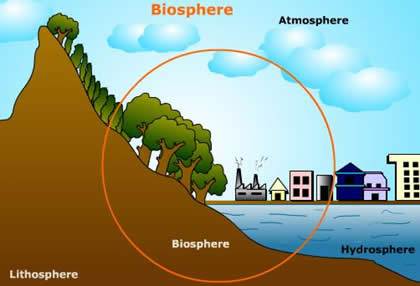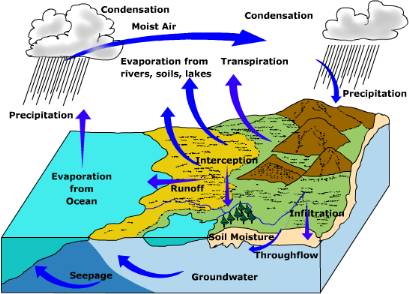Agriculture
The term "biosphere" was coined in the nineteenth century by Austrian geologist Eduard Suess in reference to the 20-kilometer-thick zone extending from the floor of the oceans to the top of mountains, within which all life on earth exists.
Thought to be more than 3.5 billion years old, the biosphere supports nearly one dozen biomes, regions of climatic conditions within which distinct biotic communities reside.
Compounds of hydrogen, oxygen, carbon, nitrogen, potassium, and sulfur are cycled among the four major spheres, one of which is the biosphere, to make the materials that are essential to the existence of life.
The other spheres are the lithosphere, the outer part of the earth; the atmosphere, the whole mass of air surrounding the earth; and the hydrosphere, the aqueous vapor of the atmosphere, sometimes defined as including the earth?s bodies of water.
The Water Cycle
The most critical of these compounds is water, and its movement among the spheres is called the hydrologic cycle. Dissolved water in the atmosphere condenses to form clouds, rain, and snow. The annual precipitation for any region is one of the major factors in determining the terrestrial biome that can exist.
The precipitation takes various paths leading to the formation of lakes and rivers. These flowing waters interact with the lithosphere (the outer part of the earth?s crust) to dissolve chemicals as they flow to the oceans. Evaporation of water from the oceans then supplies most of the moisture in the atmosphere. This cycle continually moves water among the various terrestrial and oceanic biomes.
Solar Energy
The biosphere is also dependent upon the energy that is transferred from the various spheres. Solar energy is the basis for almost all life. Light enters the biosphere as the essential energy source for photosynthesis.
Plants take in carbon dioxide, water, and light energy, which is converted via photosynthesis into chemical energy in the form of sugars and other organic molecules.
Oxygen is generated as a by-product.Most animal life reverses this process during respiration, as chemical energy is released to do work by the oxidation of organic molecules to produce carbon dioxide and water.
Incoming solar energy also interacts dramatically with the water cycle and the world wide distribution of biomes. Because of the earth?s curvature, the equatorial regions receive a greater amount of solar heat than the polar regions.
Convective movements in the atmosphere?such as winds, high- and low-pressure systems, and weather fronts?and the hydrosphere?such as water currents?are generated during the redistribution of this heat. The weather patterns and climates of earth are a response to these energy shifts. Earth?s various climates are defined by the mean annual temperature and the mean annual precipitation.
- Biomass Related To Energy
Biomass Related to EnergyThe relationship between the accumulation of living matter resulting from the primary production of plants or the secondary production of animals (biomass) and the energy potentially available to other organisms in an ecosystem...
- Calvin Cycle
Calvin cycleThe Calvin cycle is the principal mechanism that leads to the conversion of carbon dioxide into sugars by plants, algae, photosynthetic bacteria, and certain other bacteria that use chemicals as an energy source instead of light. The Calvin...
- Hydrologic Cycle
Hydrologic Cycle The hydrologic cycle is a continuous system through which water circulates through vegetation, in the atmosphere, in the ground, on land, and in surface water such as rivers and oceans. The sun and the force of gravity provide the energy...
- Nitrogen Cycle
Nitrogen Cycle The nitrogen cycle outlines the movement of the element nitrogen from one chemical state to another as it makes its way through a series of complex physical and biological interactions. Nitrogen (N) is one of the most dynamic elements in...
- Why Do Plants Need Light?
Friday, July 19, 2013 Stephen E. Doyle Plants are beneficial to humans and other animals in a myriad ways. The most commonly thought of benefit, that plants provide, is that they give off oxygen while taking in carbon dioxide. They, namely trees, also...
Agriculture
Biosphere Concept
 |
| Biosphere Concept |
The term "biosphere" was coined in the nineteenth century by Austrian geologist Eduard Suess in reference to the 20-kilometer-thick zone extending from the floor of the oceans to the top of mountains, within which all life on earth exists.
Thought to be more than 3.5 billion years old, the biosphere supports nearly one dozen biomes, regions of climatic conditions within which distinct biotic communities reside.
Compounds of hydrogen, oxygen, carbon, nitrogen, potassium, and sulfur are cycled among the four major spheres, one of which is the biosphere, to make the materials that are essential to the existence of life.
The other spheres are the lithosphere, the outer part of the earth; the atmosphere, the whole mass of air surrounding the earth; and the hydrosphere, the aqueous vapor of the atmosphere, sometimes defined as including the earth?s bodies of water.
The Water Cycle
 |
| The Water Cycle |
The most critical of these compounds is water, and its movement among the spheres is called the hydrologic cycle. Dissolved water in the atmosphere condenses to form clouds, rain, and snow. The annual precipitation for any region is one of the major factors in determining the terrestrial biome that can exist.
The precipitation takes various paths leading to the formation of lakes and rivers. These flowing waters interact with the lithosphere (the outer part of the earth?s crust) to dissolve chemicals as they flow to the oceans. Evaporation of water from the oceans then supplies most of the moisture in the atmosphere. This cycle continually moves water among the various terrestrial and oceanic biomes.
Solar Energy
The biosphere is also dependent upon the energy that is transferred from the various spheres. Solar energy is the basis for almost all life. Light enters the biosphere as the essential energy source for photosynthesis.
Plants take in carbon dioxide, water, and light energy, which is converted via photosynthesis into chemical energy in the form of sugars and other organic molecules.
 |
| Easy DIY Aquaponics |
Incoming solar energy also interacts dramatically with the water cycle and the world wide distribution of biomes. Because of the earth?s curvature, the equatorial regions receive a greater amount of solar heat than the polar regions.
Convective movements in the atmosphere?such as winds, high- and low-pressure systems, and weather fronts?and the hydrosphere?such as water currents?are generated during the redistribution of this heat. The weather patterns and climates of earth are a response to these energy shifts. Earth?s various climates are defined by the mean annual temperature and the mean annual precipitation.
- Biomass Related To Energy
Biomass Related to EnergyThe relationship between the accumulation of living matter resulting from the primary production of plants or the secondary production of animals (biomass) and the energy potentially available to other organisms in an ecosystem...
- Calvin Cycle
Calvin cycleThe Calvin cycle is the principal mechanism that leads to the conversion of carbon dioxide into sugars by plants, algae, photosynthetic bacteria, and certain other bacteria that use chemicals as an energy source instead of light. The Calvin...
- Hydrologic Cycle
Hydrologic Cycle The hydrologic cycle is a continuous system through which water circulates through vegetation, in the atmosphere, in the ground, on land, and in surface water such as rivers and oceans. The sun and the force of gravity provide the energy...
- Nitrogen Cycle
Nitrogen Cycle The nitrogen cycle outlines the movement of the element nitrogen from one chemical state to another as it makes its way through a series of complex physical and biological interactions. Nitrogen (N) is one of the most dynamic elements in...
- Why Do Plants Need Light?
Friday, July 19, 2013 Stephen E. Doyle Plants are beneficial to humans and other animals in a myriad ways. The most commonly thought of benefit, that plants provide, is that they give off oxygen while taking in carbon dioxide. They, namely trees, also...
